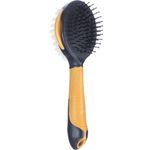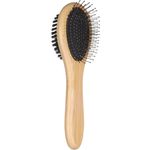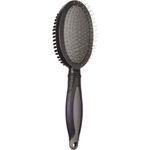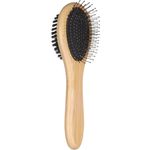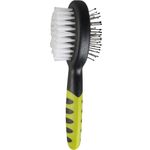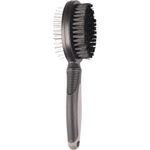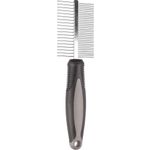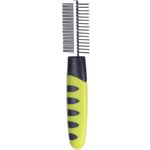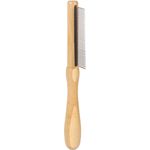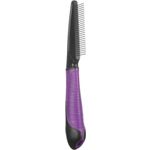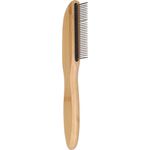Which brush or comb does my dog need? The ultimate guide for every coat type!
Every dog deserves a healthy, shiny coat – and it all starts with the right grooming. But with so many different brushes, combs, and grooming tools on the market, it’s not always easy to know which one to use and when.
In this comprehensive blog, you’ll discover exactly which brush or comb suits your dog’s coat type, how often you should brush, and why regular grooming is so important for your four-legged friend’s health. Soon, your dog won’t just be the best-looking, but also the happiest dog in the park.
What types of dog coats are there?
Before choosing a brush, it’s important to know what kind of coat your dog has. The main categories are:
- Short coat (smooth, harsh, wire-haired)
- Medium-length coat
- Long coat
- Curly or woolly coat
- Specific breeds with unique coat structures
Medium-length coat: depends on the undercoat
For dogs with medium-length coats, the amount of undercoat plays a big role in their grooming routine. Breeds like the Cocker Spaniel or Maltese usually have less undercoat and are more prone to tangles. A straight pin brush is useful for loosening light mats, and can be combined with a wide-tooth comb for finishing and reaching difficult areas.
For breeds with a thick undercoat, such as the Border Collie or Golden Retriever, it’s important to remove dead hairs promptly with an undercoat rake or deshedding tool. Always use a spray conditioner to keep the coat supple and avoid pulling. During shedding periods, brushing daily is best; outside these times, two to three times a week is sufficient.
Outside the shedding phase, focus on preventing mats in the longer coat areas such as the legs, ears, belly and chest. Use a straight pin brush, bristle brush or wide-tooth comb for this.
Undercoat rakes or trimming blades should only be used during shedding as they target the undercoat specifically.
Curly or woolly Coat: Mat-prone and intensive
Dogs with curly or woolly coats such as Poodles, Labradoodles and Bichons Frisés require the most work. Their coats mat quickly and need regular brushing.
A straight pin brush is indispensable here, as it detangles without pulling. It works best combined with a good detangling spray or conditioner, which makes the hair more supple and helps prevent mats. Normally, you comb before washing, but you can also use a conditioner to reduce matting. Regular trimming or clipping is necessary – on average every six to eight weeks
Puppies and senior dogs: Softness first
Both puppies and older dogs have sensitive skin. Start as early as possible with short, positive brushing sessions - from about eight weeks old – to get them used to being touched. Use a soft brush or rubber glove to start playfully. Reward good behaviour generously and build up slowly. The same principles apply to older dogs: keep it short, gentle and comfortable.
Tips from Vanessa, dog lover with grooming expertise
What are the most common brushing mistakes?
The biggest mistake is brushing dogs too often. Outside the shedding seasons — and unless your dog has a special coat type — grooming needs are usually minimal.
That’s why it’s important to do your research and, if needed, ask your breeder for advice — so you know exactly how to care for your dog’s specific coat type.
How do you teach a dog to enjoy brushing?
The saying "good habits start young" certainly applies here. Begin brushing and handling your puppy early to help them grow comfortable with it. Keep sessions short, as it’s tiring for puppies. Don’t start brushing immediately; let your dog sniff the brush first and build up gradually. Offer treats to make the brushing experience positive.
Using clippers or electric tools? Get your dog used to the noise first so they’re not scared.
Thinking about taking your dog to a groomer during shedding? Introduce your puppy to the groomer early. Many groomers offer free or special puppy sessions so your dog can get comfortable with the salon.
Which brush is often used incorrectly – and why?
The universal brush (slicker) is often used incorrectly. Many use it during non shedding phases, but it should only be used during shedding.
The slicker has sharp pins that penetrate deep, so be careful not to damage the coat.
I’ve even pricked my own nail bed on those pins – it hurts! My advice: always place the brush with the pins down on the table or floor so your dog can’t accidentally step on it
What are your favourite tools for home use?
During shedding, I like the universal brush (slicker). It feels comfortable in the hand and is very effective.
After grooming, I use a soft brush to give the coat a lovely shine.
Find the right brush for your dog at Flamingo
Whether your dog has a smooth coat, fluffy puppy coat or is a real curly-haired cutie – we have the right tools for every dog. Discover our range of dog brushes, combs, clippers and grooming products on our website or in-store.
in a nutshell
It depends on the coat type and the coat’s phase:
- Short hair: 1-2 times a week
- Medium-length hair: 2-4 times a week
- Long/curly hair: daily












